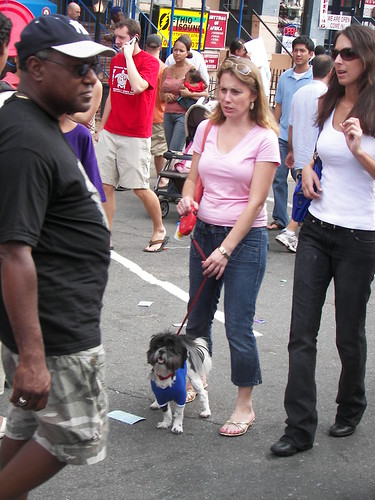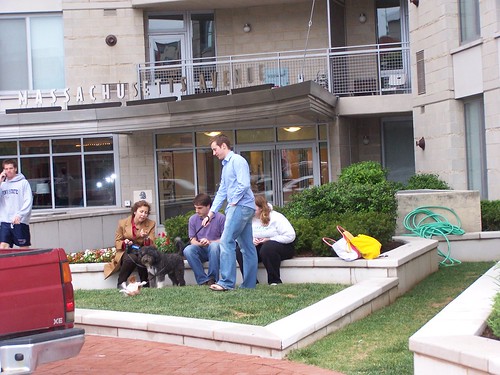Dogs and the city
Well, sure, in many quarters in DC, "dog parks" is a phrase meant as code for both "white people moving in" and neighborhood change or "gentrification."
 As I have written before ("A breakdown in a functioning civil society" from 2009 and "Love 'em and leash 'em" from 2005), dogs and dog walking are important elements of "social bridges*" and adding positive activity to the street. The creation of dog parks also brings more people out to parks and potentially helps to develop community and advocates supporting public space improvements.
As I have written before ("A breakdown in a functioning civil society" from 2009 and "Love 'em and leash 'em" from 2005), dogs and dog walking are important elements of "social bridges*" and adding positive activity to the street. The creation of dog parks also brings more people out to parks and potentially helps to develop community and advocates supporting public space improvements.Dogs as an element of the city has not gone unnoticed by retailers and commercial district planners--I remember at a Main Street conference a few years ago one of the presenters made the point that commercial districts, to remain vital, need pet stores, and you see this in many neighborhoods now in DC, and Petco's city-sized version of smaller stores designed for spaces not capable of supporting or fitting a big box store of 20,000 s.f. or larger.
Accommodating pets and dogs specifically is something that apartment building operators are doing too.
 Yesterday's Wall Street Journal has an article on this, "Dogs Get Their Due," and I have noticed it happening already at one of the buildings in NoMA, which is providing a dog washing room with a door to the outside, a plastic poop bag dispenser, and is designating apartments in one particular area of the building for dog owners specifically, in part probably to contain barking and make it easy for dogs+owners to get in and out of the building.
Yesterday's Wall Street Journal has an article on this, "Dogs Get Their Due," and I have noticed it happening already at one of the buildings in NoMA, which is providing a dog washing room with a door to the outside, a plastic poop bag dispenser, and is designating apartments in one particular area of the building for dog owners specifically, in part probably to contain barking and make it easy for dogs+owners to get in and out of the building. -------
* William Whyte called triangulation the process by where "some external stimulus provides a linkage between people and prompts strangers to talk to other strangers as if they knew each other." (p. 154, The City).
From "Design Guidelines for Greenways," from the concluding chapter of Dr. Anne Lusk's dissertation titled "Guidelines for Greenways: Determining the Distance to, Features of, and Human Needs Met by Destinations on Multi-Use Corridors." University of Michigan.):
Except for a minimal number of elements, the environment does not facilitate interaction between strangers. While someone could hold open a door and a person passing through could say thank you, necessary ADA regulations are making many doors automatic. If social capital is to be increased and interaction between people who know one another and people who do not know one another improved, environments that might foster positive interaction should be built. At the destinations, social bridge elements could be incorporated in the built environment. These social bridge elements include four types: 1) Assist, 2) Connect, 3) Observe, and 4) In Absentia.
Labels: apartments, dog parks, parks planning, urban design/placemaking



1 Comments:
Dog park issues in Boston.
https://www.bostonglobe.com/2023/08/04/metro/boston-dog-parks
Mentions how some cities have used dedicated off leash hours in parks as a public safety strategy.
Other cities have taken different approaches to dogs, designating off-leash areas within parks, often during specific times when the parks are least used. Boise, Idaho, the top city for dogs on the Trust for Public Land’s list, lets dogs hike unleashed through most of its 190-mile trail system. San Francisco, which ranked fifth, allows dogs to romp through the sand year round at several beaches.
In New York City, officials have insisted that giving dog owners the run of certain parks
before 9 a.m. and after 9 p.m. played a key role in driving down crime in parks, and has also made the city’s dogs less aggressive. The city has 69 parks with off-leash hours, including the famed Central Park, and 81 smaller fenced dog parks.
Many of Boston’s suburbs have taken the same approach, or are considering doing so. Newton, Brookline, Cambridge and Arlington started their programs between 2003 and 2010. Medford and Needham are considering the idea.
Boston parks officials briefly considered off-leash hours in 2016, and again last year. But they decided against the approach because of concerns over the damage dogs could cause to the grass, the lack of staff to enforce the hours, and opposition from parents, sports teams, and others.
Post a Comment
<< Home